#ethernet module
Explore tagged Tumblr posts
Text
Unveils High-Demand Allen-Bradley Modules and Components for Industrial Efficiency
ROC Automation, a trusted provider of automation solutions, has announced the availability of several in-demand Allen-Bradley components designed to meet the evolving needs of manufacturing and processing industries. The featured lineup includes advanced fiber transceivers, the energy-efficient Allen-Bradley PowerFlex 525 drive, the adaptable 1734 POINT I/O output module, and the reliable 1746-NT4 thermocouple input module.
This expanded offering aims to support industries seeking to modernize plant operations with smarter connectivity, precision control, and scalable architectures.
Industrial Networking Redefined with Fiber Transceivers
As operations scale, maintaining network integrity becomes increasingly critical. Allen-Bradley's fiber transceivers, such as the 1783-SFP100LX, are designed to support long-distance communication over fiber optics while minimizing electromagnetic interference. Ideal for environments where data reliability is paramount, these transceivers extend connectivity across complex, multi-building facilities without compromising speed or uptime.
Boosting Motor Control Efficiency: Allen-Bradley PowerFlex 525
Energy consumption and motor performance go hand-in-hand in modern automation. The Allen-Bradley PowerFlex 525 AC drive delivers both, offering scalable motor control for applications ranging from conveyors to mixers. Built with an innovative modular design, this 3 HP drive supports embedded Ethernet/IP and Safe Torque-Off, providing flexible integration while promoting workplace safety. Its compact footprint makes it a top choice for OEMs and system integrators looking to optimize cabinet space.
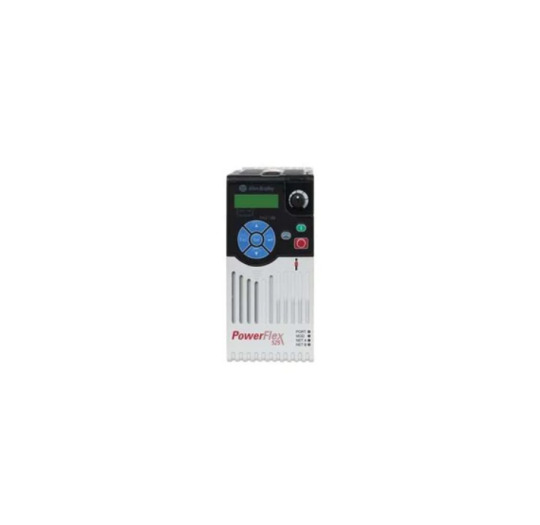
Expandable, Space-Saving Control: 1734 POINT I/O
System designers continue to gravitate toward distributed I/O systems for their flexibility and cost-efficiency. The 1734 POINT I/O platform meets these demands with modules like the 1734-OE4C analog output, offering four high-resolution channels in a space-saving design. With its ability to mount on DIN rails and communicate via Ethernet/IP, this solution scales easily as plant needs grow.
Temperature Monitoring with Precision: 1746-NT4
Accurate temperature readings are crucial in food processing, chemical production, and energy applications. The 1746-NT4 thermocouple input module, part of the Allen-Bradley SLC 500 family, provides four input channels with compatibility across a wide range of thermocouple types. Its rugged build and dependable performance ensure that process temperature data remains consistent and actionable.
Supporting Smarter Industrial Growth
The newly featured components from Allen-Bradley represent a continued push toward intelligent automation. From robust fiber transceivers to modular drives and scalable I/O solutions, each product supports efficient control and connectivity in demanding industrial settings.
About ROC Automation: ROC Automation delivers reliable industrial automation equipment from leading brands, offering both new and sealed units to ensure quality and performance across automation infrastructures.
0 notes
Text
Maximizing Efficiency with Autoclass in IEEE 802.3bt PoE: Why It Matters
Power over Ethernet (PoE) has transformed the way modern networks are designed — offering the dual benefits of data and power transmission over a single cable. This dramatically reduces installation costs and simplifies network planning by removing the need for separate electrical outlets near devices. But as networked devices continue to demand more power, optimizing how that power is allocated becomes critical. This is where Autoclass (AUC), a feature of the IEEE 802.3bt PoE standard, plays a game-changing role.
Why IEEE 802.3bt Is a Big Leap Forward
Introduced in September 2018, the IEEE 802.3bt standard was developed to meet the increasing power needs of modern devices such as CCTV cameras, Wi-Fi access points, thin clients, 5G equipment, and more. It builds on earlier standards — IEEE 802.3af (Type 1) and IEEE 802.3at (Type 2) — by delivering much higher power using all four wire pairs in an Ethernet cable. This enables power levels up to 90W at the Power Sourcing Equipment (PSE) and 71.3W at the Powered Device (PD).
The Role of Autoclass in Optimizing Power Use
In older PoE standards, the PSE allocated power based on preset classifications, often overestimating the actual need of the PD. This approach was inefficient, particularly when using shorter cables or higher-quality Ethernet like Cat6, where actual power loss is minimal.
Autoclass, a key feature in IEEE 802.3bt, solves this by allowing PDs to report their true maximum power requirement. During the classification phase, a PD signals its intent to use Autoclass by briefly adjusting the classification current. Once the device powers up, it draws its maximum required power, enabling the PSE to allocate just enough — no more, no less.
The result? More available power across the switch, reduced energy waste, and a more scalable, cost-effective PoE deployment.
Real-World Examples: Power Savings with Autoclass
Let’s consider two scenarios that highlight Autoclass optimization:
1. Using High-Quality Copper Cable
A PD requires 65W. Without Autoclass, the PSE defaults to allocating 90W (Class 8). With Autoclass, the PSE correctly adjusts to supply just 68.82W, saving over 21W per port. In an 8-port setup, that’s a saving of more than 160W.
2. Using Lower-Cost Copper-Aluminum Cable
With a 70W PD, Autoclass reduces unnecessary allocation from 90W to 73.78W, saving nearly 17W per port. Across 8 ports, that’s a total of 134W in power savings.
PoweredEthernet™ Products with Autoclass Support
Infomart’s PoweredEthernet™ IEEE 802.3bt modules — including the PEM9300BT (Class 8), PEM6300BT (Class 6), and PEB9300BT all-in-one PD boards — feature optional Autoclass support. This empowers system designers to maximize efficiency and lower costs while ensuring robust and reliable performance.
Additionally, these products offer Maintain Power Signature (MPS), another IEEE 802.3bt feature that allows ultra-low standby power consumption without disconnection risk — plus built-in wall adapter redundancy, all with minimal external components.
Conclusion: Autoclass is the Smart Choice for Smart Networks
Autoclass is more than a technical upgrade — it’s a critical enabler for modern, power-efficient networks. Whether you’re deploying a high-density PoE switch or designing next-gen connected devices, leveraging IEEE 802.3bt with Autoclass ensures optimal performance, significant cost savings, and a future-ready infrastructure.
0 notes
Text

iNRCORE 100B-2002 10/100 Base-TX dual-port Ethernet transformer module
0 notes
Text

The GE Fanuc IC695ETM001-EM Ethernet Interface Module is designed for high-speed data communication in PACSystems RX3i controllers. It offers reliable Ethernet connectivity, allowing easy integration with industrial networks. This module supports 10/100 Mbps data rates, real-time control, and remote diagnostics. With its robust design and easy installation, it ensures seamless communication between devices, improving system efficiency. Ideal for factory automation, SCADA systems, and machine control, the IC695ETM001-EM boosts productivity and system performance. Shop this dependable Ethernet module at Auto2mation for your automation needs.
#industrial automation#industrial equipment#industrial spare parts#industrial#automation#industrial and marine automation#industrial parts supplier#industrial innovation#automation solutions#Marine Automation#marine equipment#marine spare parts#auto2mation#Ge fanuc#ethernet interface module#iomodules#pcb
0 notes
Text
Enhancing Textile Machinery Efficiency with Messung's NX-ERA Xpress PLC

The textile industry, being a part of global manufacturing, has witnessed a massive transformation in recent years due to accelerated technological advancements. From yarn making to dyeing yarns with complex patterns, each process of textile production has been streamlined for higher productivity, accuracy, and efficiency. The need for high-quality products and shorter production cycles has generated fertile ground for automation, especially with the use of Programmable Logic Controllers (PLCs)in textile manufacturing.
This is where we at Messung Industrial Automation come in the picture with our cutting-edge automation solutions. With our strong heritage of delivering strong and scalable automation solutions, we have been the industry leader in industrial automation. Our innovative and compact PLC, NX-ERA Xpress has been crafted to specifically address the specific requirements of industries such as textile manufacturingwith the ideal combination of performance, flexibility, and energy efficiency. In this blog, let’s explore the revolutionary potential of NX-ERA Xpress PLCand its impact on textile machinery, with an emphasis on how it improves operational efficiency, cuts costs, and accelerates the journey towards Industry 4.0.

The Role of PLCs in Modern Textile Manufacturing
Programmable Logic Controllers (PLCs) form the foundation of automation in textile manufacturing, especially in the "cotton to yarn" and "yarn to fabric" segments where their role is most critical. These rugged, industrial-grade controllers ensure precision, speed, and efficiency by managing machinery and processes in real time. From ginning and bale plucking to spinning, carding, drawframe, combing, ring frame machines, and autoconers, PLCs are deeply embedded in every stage of the cotton-to-yarn journey.
In the yarn-to-fabric sector, PLCs continue to play a significant role in the operation of warping machines, twisting machines, and various types of looms such as shuttle, airjet, and rapier looms. They are equally vital in fabric processing lines, managing singeing, bleaching, dyeing, and a wide range of finishing machines designed to enhance textile properties like softness, wrinkle resistance, or water repellency. Printing lines, including rotary and flat bed printing machines, also rely heavily on PLC-controlled automation.
Across these applications, PLCs are integrated with Human Machine Interfaces (HMI), Variable Frequency Drives (VFDs), and in high-speed machines like spinning lines, Servo amplifiers and Servo motors are used for superior speed and torque control.
While the garment sector (fabric to garment) does involve automation, Messung’s core expertise and solutions, including the NX-ERA Xpress PLC and NX-ERA Jet PLC, are primarily focused on the earlier and more automation-intensive stages of textile manufacturing.
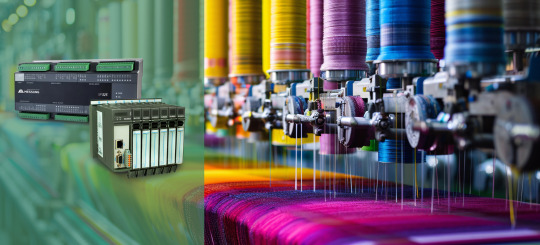
Benefits of Implementing PLCs on Textile Machinery
Increased Efficiency: PLCs allow streamline operations by automating processes that were previously manual, significantly reducing downtime and increasing throughput
Improved Accuracy: The high-level precision control afforded by PLCs ensures each activity in the fabric process, whether spinning or weaving, is undertaken with perfection.
Real-Time Monitoring: PLC-based systems make equipment monitoring in real-time a certainty, where defects are flagged off early and avoid costly downtime along with plant operation performance improvements.
As the textile industry advances, compact PLCs are not an indulgence but a must-have. Automation is the key to staying competitive, and industrial automation PLC systems like the NX-ERA Xpress are at the forefront of this revolution.
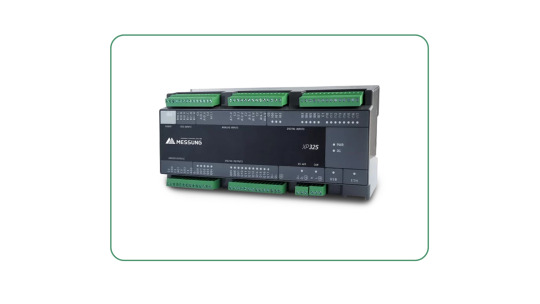
Learning More About NX-ERA Xpress PLC
The NX-ERA Xpress PLC is our response to the increasing needs of the textile industry. By harnessing the capability of Programmable Logic Control Systems and the flexibility of contemporary communication protocols, the NX-ERA Xpress provides a powerful and scalable solution for numerous industrial automation applications.
Features of NX-ERA Xpress PLC:
High-Density Digital and Analog I/O: The NX-ERA Xpress PLC features a high-density I/O design that is capable of processing vast amounts of data input and output at one time. This is important for the textile industry, where real-time data from many machines need to be processed efficiently in order to optimize performance.
Programming through Codesys® (IEC 61131 Standard): Among the most impressive aspects of the NX-ERA Xpress PLC is its support for Codesys®, an open-source programming platform. This standardization enables seamless integration with industrial equipment across the board, which makes it an attractive option for PLC manufacturing companies.
Integrated Communication Protocols: With inbuilt compatibility for communication protocols such as Ethernet TCP/IP, Modbus, and CANopen, the NX-ERA Xpress PLC facilitates smooth connectivity among various machines and devices on the shop floor. This connectivity is vital for ensuring smooth operation throughout the complete manufacturing process.
Industry 4.0 Readiness: NX-ERA Xpress PLC comes with OPC-UA and MQTT readiness, making it Industry 4.0-ready. These are technologies that support data exchange over different platforms, and they simplify the integration of machines by manufacturers into a smart factory environment.
Integrated HTML Web Server for Remote Monitoring: Remote monitoring has never been simpler. The integrated HTML web server enables operators to monitor and control the PLC remotely, offering flexibility and real-time visibility into machine performance.
The high-performance features and compact PLC design of NX-ERA Xpress PLC make it perfect for the textile industry. Whether you're automating cotton spinning, weaving, or dyeing, the NX-ERA Xpress provides all the power you need to optimize your operations.
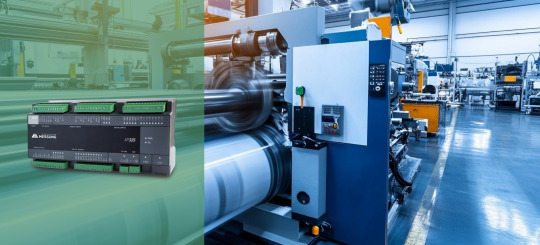
Advantages of NX-ERA Xpress in Textile Applications
The textile industry requires solutions that are capable of providing not just high performance but also cost-effectiveness and sustainability. Our NX-ERA Xpress PLC provides a number of benefits for applications in textile machinery, such as:
Energy Efficiency
In the textile industry, energy consumption is a major operational expense. The NX-ERA Xpress PLC is built to maximize control and minimize power consumption, especially in power-hungry processes such as spinning. Through automation processes and optimizing machine efficiency, the PLC ensures textile plants make substantial savings on energy.
High-Speed Processing
Textile production processes often involve rapid and adaptive control systems that are necessary for handling high-speed manufacturing lines. The processing of high speeds facilitated by the NX-ERA Xpress PLC helps data move faster to provide instant adjustment capabilities, ensuring minimum lags in manufacturing processes.
Precision Control
The clothing industry is based on the effective control of variables like thread tension, fabric alignment, and dying processes. NX-ERA Xpress PLC ensures accurate control in order to match every parameter in the manufacturing process to the prescribed specifications. The result is repetitive product quality, and less it is defective.
Scalability
As textile factories develop and expand, scalable automation systems become increasingly relevant. NX-ERA Xpress PLC uses a modular construction that means that automation systems can be expanded as they are required by manufacturers, presenting a great solution for expanding businesses in the textile industry in the long term.
Cost-Effectiveness
Automation must not be expensive. The NX-ERA Xpress PLC is an affordable solution for textile producers that offers high-end features without an exorbitant price tag. It is meant to offer high-performance at an affordable rate, so any textile firm can use it.

Textile Machinery Applications: PLC Precision for a Modern Mill
As textile factories embrace digital transformation, the NX-ERA Xpress PLC emerges as a compact yet powerful solution tailored for automation-ready textile machinery. With its robust control features and Industry 4.0 connectivity, the NX-ERA Xpress brings intelligence and agility to a wide range of textile processes.
Let’s explore key use cases across the textile value chain:
Yarn Steaming Machine:
Steaming is a critical stage in yarn preparation where temperature, pressure, and timing must work in harmony. The NX-ERA Xpress PLC ensures:
Precise control of temperature and steam pressure for consistent yarn conditioning
Regulation of steaming duration to match different yarn types and production speeds
Automation of loading and unloading mechanisms, reducing manual intervention and boosting throughput
With its real-time responsiveness and compact design, the NX-ERA Xpress PLC enhances efficiency, consistency, and reliability in yarn steaming operations.
Heat Setting and Space Dyeing Machine Integration:
In advanced textile finishing, seamless integration between heat setting and dyeing is essential. NX-ERA Xpress PLC brings synchronization and control to:
Temperature management for precise heat setting, improving dimensional stability and dye fixation
Control of dye application in the space dyeing process, enabling unique patterns with consistent results
Coordination of material flow between machines, ensuring smooth transitions and avoiding process bottlenecks
The result is an integrated, high-performance workflow for specialty dyeing applications, digitally governed for optimal output and reduced waste.
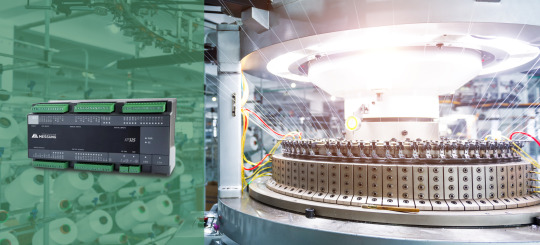
Integration with Messung's Automation Ecosystem
One of the major strengths of the NX-ERA Xpress PLC is that it can integrate smoothly with all our other products, like the XM-PRO remote I/O modules. This makes it possible to have a unified automation solution that simplifies the control and monitoring of your entire textile plant.
With a single provider for all automation needs, textile manufacturers can enjoy streamlined operations, reduced complexity, and improved support. The synergy between the NX-ERA Xpress PLC and our other products ensures that your factory is fully equipped to tackle the challenges of modern textile manufacturing.
Conclusion
In summary, our NX-ERA Xpress PLC is a game-changer in the textile sector, providing powerful, scalable, and affordable automation. With its high-performance capabilities, energy efficiency, and accurate control, the NX-ERA Xpress PLC is ideally positioned to address the changing needs of textile producers.
With the NX-ERA Xpress PLC, you can elevate your textile manufacturing process to the next level. Whether you want to optimize spinning, weaving, or dyeing processes, Messung's automation solutions provide the reliability and performance that you require to remain ahead in a competitive market.
So, why wait? Consult Messung today for a customized automation solutionthat suits your textile manufacturing needs. It’s time to embrace the future of textile production with the NX-ERA Xpress PLC - where automation meets innovation
#textile manufacturers#Programmable Logic Controllers (PLCs)#textile manufacturinG#cutting-edge automation solutions#compact PLC#NX-ERA Xpress PLC#textile machinery#Industry 4.0#spinning#carding#drawframe#combing#ring frame machines#autoconers#singeing#bleaching#dyeing#PLC-controlled automation.#NX-ERA Jet PLC#industrial automation#PLC systems#IEC 61131 Standard#Ethernet TCP/IP#Modbus#CANopen#cotton spinning#automation processes#remote I/O modules#automation needs#customized automation solution
0 notes
Text
https://www.futureelectronics.com/p/semiconductors--comm-products--i2c/pca9532pw-118-nxp-5033862
16-bit I2C-bus LED Dimmer, Embedded communication, image processing,
PCA9532 Series 5.5 V 350 uA 400kHz SMT 16-bit I2C-bus LED Dimmer - TSSOP-24
#NXP#PCA9532PW#118#Comm Products#I2C#16-bit I2C-bus LED Dimmer#Embedded communication#image processing#High-Speed#Isolated CAN Transceiver ICs#CAN bus lines#i2c modules#Can Power Systems#CAN transceiver#Ethernet MAC controller
1 note
·
View note
Text
https://www.futureelectronics.com/p/semiconductors--comm-products--can/mcp2551-i-sn-microchip-5584800
Can Power Systems, Ethernet controller, High-Speed CAN Transceiver
MCP2551 Series 5.5 V 1 Mb/s Surface Mount High-Speed CAN Transceiver - SOIC-8
#Microchip#MCP2551-I/SN#Comm Products#CAN#Power Systems#Ethernet controller#High-Speed CAN Transceiver#Ethernet MAC controller#CAN Controller Interface#Can bus communication#Controller Interface Module#Module Bus Drive
1 note
·
View note
Text
https://www.futureelectronics.com/p/semiconductors--comm-products--i2c/pca9532pw-118-nxp-5033862
I2c bus, Embedded communication, Isolated CAN Transceiver ICs
PCA9532 Series 5.5 V 350 uA 400kHz SMT 16-bit I2C-bus LED Dimmer - TSSOP-24
#NXP#PCA9532PW#118#Comm Products#I2C#Ethernet MAC controller#communication protocol#i2c module#bus#Embedded communication#Isolated CAN Transceiver ICs#High-Speed CAN Transceiver#CAN transceiver#SPI bus#CAN bus lines
1 note
·
View note
Text
Enhancing Industrial Automation with High-Performance Allen Bradley Products
Allen-Bradley products have long stood at the forefront of industrial automation technology. Known for delivering reliability, integration flexibility, and high-speed processing, components like the 5069-L330ERMS3, 1734 ie8c, and 1783-SFP100FX are integral to building advanced control systems in manufacturing environments.
Compact and Secure Control: 5069-L330ERMS3
The 5069-L330ERMS3 Compact GuardLogix controller is engineered for applications requiring both high-speed motion control and enhanced safety. Featuring 3 MB of user memory and integrated safety functions, this controller delivers efficient communication and rapid execution rates. Designed to seamlessly fit into the Compact 5000 I/O platform, it ensures optimal performance in both standalone and distributed architectures. Its real strength lies in supporting SIL 3/PLe safety levels, a must-have for industries focused on compliance and worker protection.

Precision Current Input: 1734-IE8C
The 1734-IE8C module provides eight channels of current input in a compact form factor, making it ideal for space-constrained installations. As part of the POINT I/O family, it allows distributed control with minimal wiring and maximum configurability. This module supports 4–20 mA signals, which are widely used in process instrumentation for accurate data capture and signal integrity. It's particularly suited for systems where input scalability and ease of maintenance are critical.
Seamless Fiber Networking: 1783-SFP100FX
High-speed networking is essential in modern industrial setups, and the 1783-SFP100FX fiber transceiver meets that need with 100 Mbps Fast Ethernet capability over fiber optic cables. It offers improved noise immunity and extended communication distances, making it a solid choice for facilities with high EMI or geographically spread-out equipment. Used with Stratix switches, this hot-swappable SFP simplifies network expansion without downtime.

Final Thoughts
From safety controllers to scalable I/O and reliable fiber networking, Allen-Bradley Products like the 5069-L330ERMS3, 1734 ie8c, and 1783-SFP100FX represent smart investments in productivity and uptime. These devices not only improve performance but also bring future-ready flexibility to automation infrastructures.
#automation parts store#rocautomation#compactlogix allen bradley#ethernet module#ethernet port switch#Industrial Products
0 notes
Text
https://www.futureelectronics.com/p/semiconductors--optoelectronics--isolation-components-optocouplers/moc3043sr2m-onsemi-4354221
What is an opt isolator, Power over Ethernet (PoE) technology , Ethernet LANs,
DIP6 SMT 1 Channel 400 V 4170 Vrms Zero-Cross Triac Optoisolator
#Onsemi#MOC3043SR2M#Optoelectronics#Isolation Components#Optocouplers#opto-isolator#electronic component#optical coupler#opto isolator module#Power over Ethernet (PoE) technology#Ethernet LANs#transistor#circuit#photocoupler#optocoupler
1 note
·
View note
Text
The Benefits of using the Autoclass AUC feature in IEEE 802.3bt POE
The AutoClass (AUC) feature in IEEE 802.3bt PoE enables precise power allocation by measuring the actual power consumption of connected devices. This ensures efficient energy usage, reduces power waste, and allows more devices to be supported on a single switch. AUC enhances safety and performance while optimizing the overall cost and scalability of PoE networks.
0 notes
Text
Modbus MQTT 2 Ethernet Ports Module for Data Monitoring
The M series Ethernet Remote I/O Module is an industrial class, isolated designed, high reliability, high stability and high precision data acquisition module, embedded 32-Bit High Performance Microprocessor MCU, Integrated 1 Industrial 10/100M adaptive Ethernet module inside. It provides multi I/O, supports standard Modbus TCP, supports modbus master and slave, can be integrated into SCADA, OPC server, and other automation systems. It is design for working in the harsh industrial application environment, widely used in a variety of industrial automation, security monitoring system, automatically measurement and control system.
Features: Model: M160E Digital Inputs: 8 channels Digital Outputs: 8 channels Analog Input: 8 channels Ethernet Port: 2xRJ45 Serial Port: 1xRS485 Protocol: Modbus TCP Master or Slave, TCP/IP, MQTT Dimensions: 82x 40 x 99 mm
0 notes
Text

Ajitek Tech Solutions Pvt Ltd
0 notes
Text
Understanding Relay Module Circuits: A Comprehensive Guide
Introduction:
Relay module circuits are essential components in various electronic and electrical applications. These circuits act as switches, allowing control signals from one circuit to activate or deactivate another circuit. Relay modules provide an efficient way to isolate high-power devices from low-power control systems, ensuring safety and protection. In this comprehensive guide, we will delve into the fundamentals of relay module circuits, their working principles, applications, and address some frequently asked questions (FAQs) to provide a complete understanding of this crucial aspect of modern electronics.
I. What is a Relay Module Circuit?
A relay module circuit consists of an electromechanical relay mounted on a PCB (Printed Circuit Board). The relay is an electromagnetic switch that is actuated by a control signal, which can be either digital or analog. When the control signal triggers the relay, it closes or opens the electrical contacts, allowing current to flow through the output terminals and control external devices or circuits.
II. How Does a Relay Module Circuit Work?
Electromagnetic Coil: The relay module circuit has an electromagnetic coil that serves as the input or control element. When an appropriate voltage is applied to the coil, it creates a magnetic field, causing the relay's armature to move.
Normally Open (NO) and Normally Closed (NC) Contacts: A relay typically has two sets of contacts: Normally Open (NO) and Normally Closed (NC). In the resting state, the NO contacts remain open, and the NC contacts remain closed.
Switching Action: When the coil is energized, the armature moves, causing the NO contacts to close and the NC contacts to open. This switching action completes or interrupts the circuit, depending on the application.
III. Types of Relay Module Circuits:
Single-Pole, Single-Throw (SPST) Relay: SPST relays have one set of contacts and can either be Normally Open or Normally Closed.
Single-Pole, Double-Throw (SPDT) Relay: SPDT relays have one set of normally open contacts and one set of normally closed contacts. When the relay is energized, the NO contacts close, and the NC contacts open.
Double-Pole, Single-Throw (DPST) Relay: DPST relays have two sets of contacts that operate simultaneously, making or breaking the circuit.
Double-Pole, Double-Throw (DPDT) Relay: DPDT relays have two sets of NO contacts and two sets of NC contacts. They provide two separate circuits that can be independently controlled.
IV. Applications of Relay Module Circuits:
Home Automation: Relay modules are commonly used in home automation systems to control lighting, heating, ventilation, and air conditioning (HVAC) systems.
Industrial Automation: In industrial automation, relay modules are used to control motors, pumps, solenoids, and other high-power devices.
Automotive Electronics: In automobiles, relay modules are utilized to control various electrical systems, such as headlights, windshield wipers, and electric windows.
Robotics: Relay module circuits are used in robotics to control the movement of actuators and motors.
Security Systems: In security systems, relay modules are used to trigger alarms and control access points.
V. Advantages of Using Relay Module Circuits:
Isolation: Relay module circuits provide galvanic isolation between the control circuit and the load, ensuring safety and protecting sensitive components.
Low Power Control: Relay modules allow low-power control systems to switch high-power devices, eliminating the need for high-power control circuits.
Versatility: Relay module circuits are available in various configurations and voltage ratings, making them versatile and suitable for a wide range of applications.
Simple Operation: Relay modules are easy to install and operate, making them a popular choice in many electronic applications.
FAQs:
Q1. Can relay module circuits be used for both AC and DC applications? Yes, relay modules are available in both AC and DC versions, allowing them to be used in a wide range of applications.
Q2. What is the difference between a relay and a relay module? A relay is the basic electromagnetic switch, while a relay module includes the relay mounted on a PCB with additional circuitry for ease of use and integration into other systems.
Q3. Can relay modules handle high-current applications? Yes, relay modules are available in different current ratings, and they can handle high-current applications as per their specifications.
Q4. How do I choose the right relay module for my application? When selecting a relay module, consider the voltage and current requirements of your application, the type of load (AC or DC), and the number of contacts needed.
Q5. Can I use a relay module to control multiple devices simultaneously? Yes, some relay modules have multiple sets of contacts (DPDT or more), allowing you to control multiple devices independently.
Conclusion:
Relay module circuits are versatile and indispensable components in modern electronics and electrical systems. Their ability to provide isolation, low-power control, and versatility makes them ideal for a wide range of applications in various industries. By understanding the working principles and different types of relay modules, along with their numerous applications, designers and engineers can make informed decisions when integrating these circuits into their projects. Relay module circuits continue to play a critical role in enhancing the efficiency and control capabilities of electronic systems, contributing to advancements in automation and smart technologies.
0 notes
Text
Powering the Production Line: Messung’s NX-ERA PLCs in Automotive Material Handling

In automotive manufacturing, precision isn’t a luxury, it’s a necessity. From chassis and engine assembly lines to the press shop and paint line, seamless material handling is critical to keeping production on track. Whether it’s coordinating conveyors, pick-and-place systems, or synchronizing with robotic cells, the need for intelligent control is constant.
Messung’s NX-ERA PLCs deliver this control with unmatched flexibility. With native support for Modbus TCP/IP, Ethernet/IP, EtherCAT, OPC-UA, and IO-Link, they enable high-speed communication across robots, HMIs, VFDs, servo amplifiers, and central SCADA systems. Plus, with remote I/O modules and protocols like CANopen, our PLCs handle large-scale, distributed inputs and outputs effortlessly. Simply put, NX-ERA makes advanced, synchronized automation easy, even in the most demanding environments.
What is Material Handling in the Automotive Industry?
Material handling in the automotive industry involves the movement, positioning, storage, safety, and tracking of components and assemblies throughout the production process—from the arrival of raw materials to the final stages of vehicle assembly. Efficiency here is critical; any delay or misstep can disrupt the entire manufacturing flow.
Key areas such as the chassis and engine assembly lines, along with the press shop and paint line, rely heavily on sophisticated material handling systems, including conveyors, pick-and-place machines, and robotics, to keep production moving seamlessly. These systems must operate in perfect sync, often across large, distributed areas with thousands of I/O points.

The Brain Behind the Brawn: NX-ERA PLCs
Our state-of-the-art NX-ERA PLCs including the NX-ERA Xpress and NX-ERA Jet, are compact PLCs designed for high-speed, reliable control. These programmable logic control systems are the heart of any automated material handling system. By offering real-time control, seamless connectivity, and robust communication protocols like Modbus TCP/IP, Ethernet/IP, EtherCAT, OPC-UA, and IO-Link. They interface effortlessly with robots, HMIs, VFDs, servo amplifiers, and centralized SCADA systems, ensuring reliability and scalability.
Here are some of its most impactful features:
High-Speed Processing Power
The core point of NX-ERA PLCs is that they are capable of real-time processing. These robot systems run as fast as your machinery, and the synchronization is important for the overall efficiency of the system. This compact PLC will guarantee flawless optimization for every aspect of the bottling line, be it controlling the work of conveyors or robotic manipulation.
Modular Design for Flexibility
The greatest feature of the NX-ERA PLC is its modular design. Production plants in the automotive industry often aim for some form of adaptability, and, thus, this feature is very helpful. It allows the installation to expand while the business is developing. The implementation of modularity means that the system can be integrated with any new equipment, production units, or additional features to ensure that there will be no disruption to the system performance.
Integrated I/O Modules for Streamlined Setup
Our smart and compact PLC integration contains integrated I/O modules that reduce installation and wiring times, thus also focusing on the fast-paced phenomenon in the automotive industry. For simplification of the things, input/output capabilities are now directly included in the integrated PLC system, which substantially reduces the external wiring as a result of which the setting up is speedier and less prone to mistakes.
Advanced Web Server Capabilities
It is safe to say that we are far off the days when engineers would have to be on site for them to physically track and diagnose issues on the factory floor. The capability of the built-in web pages of our NX-ERA PLC allows easy remote access for getting the actual real-time state of the diagnostics and monitoring. This feature is incredibly important in an industry that operates around the clock, as it allows maintenance teams to resolve issues remotely, reducing downtime and keeping things running smoothly.
The Role of the NX-ERA PLCs in Material Handling
In the automotive industry, material handling is integral to the success of the production process. From raw materials to semi-finished goods, and finally to finished products, materials need to be handled with precision. Automation is key to achieving this, and Messung’s NX-ERA PLCs are designed to make this process as efficient and effective as possible.
Here is how it is done:
Conveyor Systems Optimization
Conveyor systems, which carry parts between the workstations and at the same time keep the production continuously running, are the most popular form of material handling in the automotive plants. NX-ERA PLCs make sure that the system, no matter what, functions without any breaks by adjusting the speed of the conveyors to fit the pace of production. The real-time processing feature ensures that the system in question becomes flexible almost immediately, providing the assembly line without any interruptions and preventing the end line packing in the last round.

Predictive Maintenance to Maximize Uptime
The predictive maintenance of the system is seen as the golden nugget to maximize uptime. For the maintenance of a plant, having machines down during their run time is quite expensive. In the automotive industry, where the production rates run on a very tight schedule, even a moment's disruption would mean substantial losses. Our PLC Systems use a predictive maintenance system to keep a continuous check on the condition of the equipment. The control system will be equipped with predictive maintenance, which can track the system performance, increasing the change in predicting when maintenance is needed before failure occurs. These stains would reduce chances of equipment going down and also increase whole equipment machines productivity performance.
Power Management for Material Handling Equipment

How NX-ERA PLCs Integrate with SCADA Systems
Industrial automation relies not just on PLCs but also on supervisory control and data acquisition (SCADA) systems to monitor and control large-scale operations. The integration of NX-ERA PLCs with SCADA applications enhances material handling capabilities by providing plant operators with real-time insights into the performance of material handling equipment.
Real-Time Visualization and Data Monitoring
Data gathered from the cluster of service line sensors are then monitored by SCADA systems through real-time visualization and data troubling. By means of the material handling systems' connecting to the SCADA applications, operators are able to visualize every operation stage on a single interface. Our NX-ERA PLC assists the SCADA system in a way that allows real-time data visualization. As for plant automation, this integration enables the operators to redesign the production line and fabricate the survey that they are in full command, including the conveyor speed, robotic movement, and electrical power consumption.

Alarming and Fault Diagnostics
Unexpected malfunctions are a part of any complex system, but SCADA and PLC integration ensures they are dealt with swiftly. The NX-ERA PLC can send alerts to SCADA systems when material handling equipment encounters an issue, whether it’s a malfunction in a conveyor belt, a sensor failure in a robotic arm, or an electrical fault. This proactive approach helps resolve issues before they lead to extended downtime.
Historical data analysis for continuous improvement
Other benefits of integrating the SCADA system with the NX-ERA PLC is to have an ability to analyse historical data. These past data performances can better help the plant managers to see trends, adjust production schedules, and improve the efficiency of the material-handling systems over the long period. In actuality, the PLC saves and disposes of necessary data. This information, then, is fed into the SCADA system and used for analysis and presentation purposes.
The Future of Material Handling with NX-ERA PLCs
As the automotive industry embraces Industry 4.0, NX-ERA PLCs are positioned at the forefront of the shift towards smarter, more connected manufacturing systems. This is brought about by switching to smarter, more connected production systems. Thanks to NX-ERA PLCs, which are able to integrate with SCADA applications, robots, and power supplies, you can now easily build a factory that can quickly adapt to changes in the current demand and the production process.
Benefits Include:
More automation and efficiency with the increasing factories
As factories become more automated, the role of PLCs like the NX-ERA will only grow. The future of material handling will rely on even more precise and automated systems, from fully autonomous robots to smart conveyors that adjust their speed and behavior based on real-time conditions. The NX-ERA PLC is ready to support this evolution with its high-speed processing and robust integration capabilities.
Energy Management and Sustainability
Green manufacturing is a critical concern for the industry today. Automotive manufacturers demand advanced NX-ERA PLCs in a bid to bring down the environmental impact of the production. An essential element that plays a pivotal role in power solutions, predictive maintenance, and derived data for operational efficiency is a way for these to reduce the consumption of energy.
Real-Time Data and IoT Connectivity
With the rise of the Internet of Things (IoT) in manufacturing, NX-ERA PLCs will continue to integrate with a broader network of connected devices. This real-time data flow will empower automotive plants to make more informed decisions and improve their material handling systems.
Conclusion: The Future of Material Handling in the Automotive Industry

In the race for efficiency and innovation, Messung’s NX-ERA PLCs are the pit crew that keeps material handling equipment running at peak performance. Their combination of advanced features, modular design, and seamless integration with SCADA systems positions them as the ideal solution for automotive manufacturers aiming to stay ahead of the competition.
As automotive plants move towards smarter, more automated manufacturing processes, the need for reliable, high-performing PLCs like the NX-ERA will only continue to grow. By embracing the capabilities of Messung’s NX-ERA PLCs, automotive manufacturers can ensure that their material handling systems operate efficiently, sustainably, and with minimal downtime, ultimately contributing to the ongoing success of the industry.
In this fast-paced industry where precision is the name of the game, Messung’s NX-ERA PLCs are the game changers that automotive manufacturers need to optimize their material handling systems and maintain a competitive edge in the global market.
#chassis and engine assembly lines#Modbus TCP/IP#Ethernet/IP#EtherCAT#OPC-UA#remote I/O modules#CANopen#compact PLCs#programmable logic control systems#SCADA systems#automotive industry#PLC system#material handling#PLC Systems#material handling systems#SCADA applications#PLC integration#Automotive manufacturers#Internet of Things (IoT)
0 notes
Text
while im grateful for the easy A this basic pc applications class is. so tedious. every module so far has been approximately 20 one-minute videos with a question between before you can move to the next. and the videos are like "the internet is how you connect your computer to others. you can use wifi or ethernet" pleaaaaase
#its literally a degree requirement for some reason or i would not waste my time and money#sams ramblings
7 notes
·
View notes